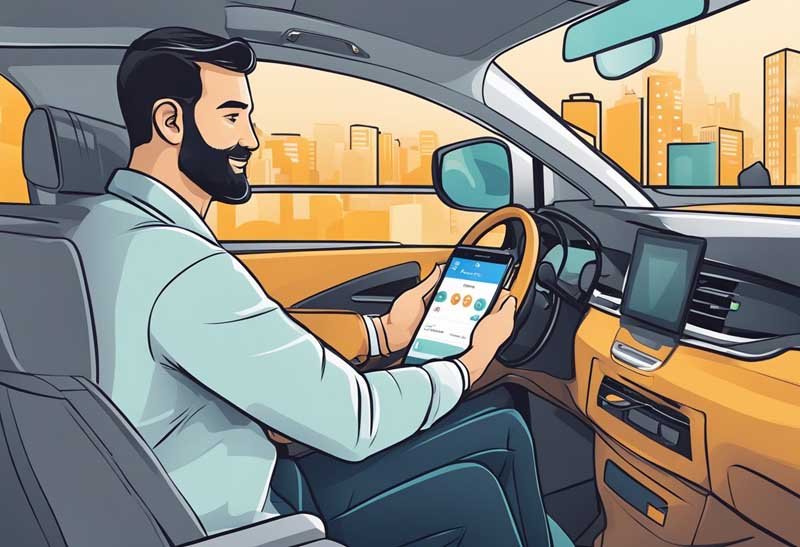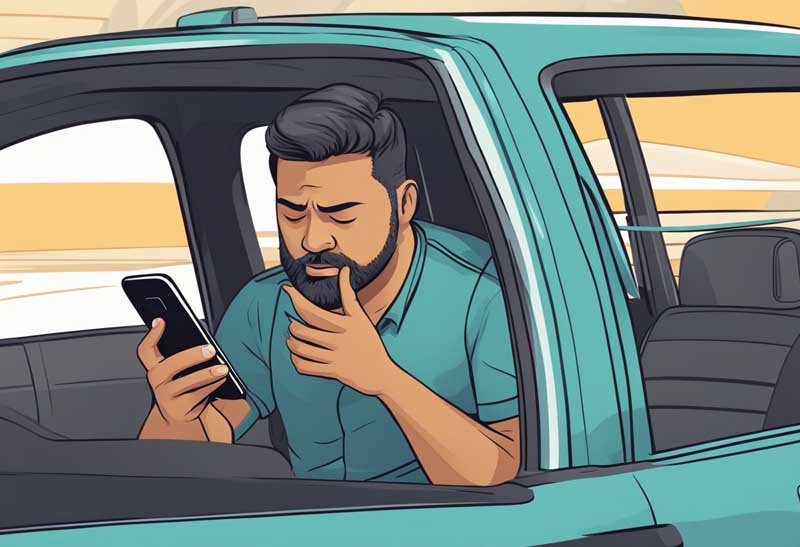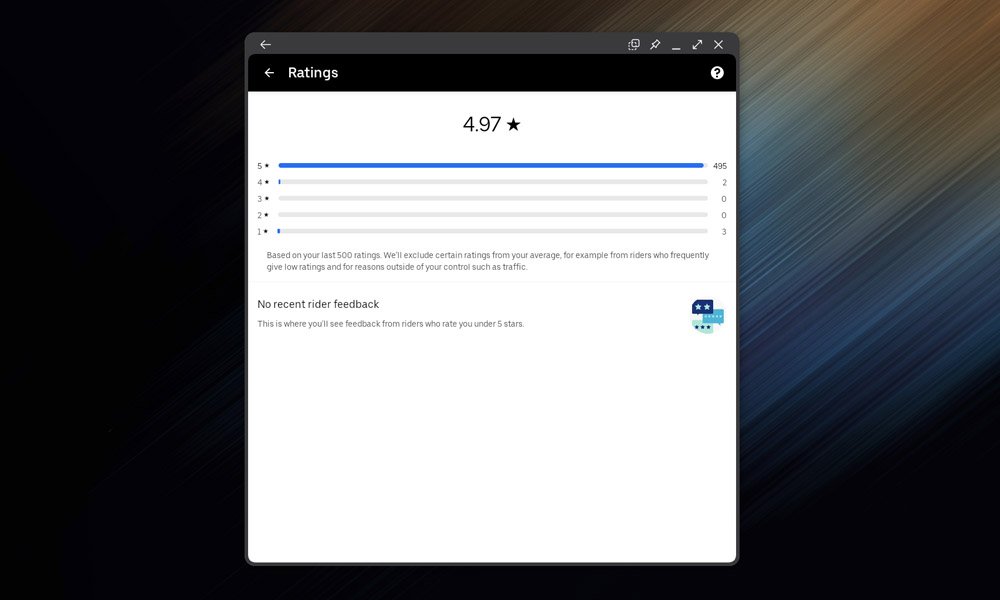When you take a ride with Uber, your driver’s service quality is reflected in a rating system designed to maintain a standard of professionalism and satisfaction on the platform. Each journey ends with the opportunity for you and your driver to rate each other, contributing to an overall average that influences future interactions on the app. Your feedback plays a crucial role not only in the driver’s ongoing access to work through the app but also in ensuring that the Uber community remains safe and respectful.
Navigating the Uber driver rating system is straightforward – after each trip, riders are prompted to rate their driver on a scale from one to five stars. This rating is a direct reflection of the service provided, with five stars indicating excellent service. However, a consistently low score could signify that a driver needs to focus on improving certain aspects of their service to avoid jeopardising their standing on the platform.
Key Takeaways
- Rider ratings hold significant weight in maintaining Uber’s service quality.
- A driver’s ability to work on the platform can be influenced by their average rating.
- The rating interface is user-friendly, encouraging honest and prompt feedback post-trip.
Understanding the Uber Driver Rating System

Uber’s driver rating system is a crucial feedback mechanism that maintains the quality and safety of the Uber experience. Both drivers and riders participate in a two-way rating process after each trip, contributing to a driver’s overall score.
Components of the Rating System
The Uber driver rating system is built upon individual ratings submitted by riders. After each trip, the riders have the opportunity to rate their driver on a scale from one to five stars. These ratings reflect a variety of factors including the driver’s punctuality, the vehicle’s cleanliness, and the overall experience of the trip.
Additionally, the system supports anonymity to ensure that riders can rate honestly without affecting their relationship with the driver. Notably, the average Uber driver rating is publically visible on a driver’s profile, creating a transparent environment for potential customers.
How Ratings Are Calculated
Your average Uber driver rating is determined by calculating the mean of the most recent 500 ratings you’ve received. If you haven’t yet received 500 ratings, then it calculates based on as many as you have. Maintaining a high average is paramount, as a consistently low score may result in the loss of access to the Uber platform.
In London, as well as in other cities, Uber does not stipulate a minimum driver rating threshold that you must stay above. Although Uber does not publicly disclose this minimum threshold, it is widely understood that you should aim to keep your average well above 4.6 to ensure a good standing. Failure to maintain this minimum can lead to a review of your partnership with Uber.
Significance of Driver Ratings
Your success as an Uber driver relies heavily on your star rating. This rating reflects your quality of service and can influence both your current opportunities and future growth on the platform.
Impact on Driver Opportunities
A high Uber star rating is synonymous with excellence and can lead to qualification for premium services such as Uber Exec in the UK – accessible for drivers maintaining a rating of 4.9 or above and 4.85 for Uber Comfort. In the US counterpart, a 4.85 rating or higher opens doors to Uber Black.
What Counts as a Good and Bad Rating?
- A good Uber driver rating: 4.6 or above
- A borderline Uber driver rating: between 4.4 to 4.6
- A bad Uber driver rating: below 4.4
Having a higher rating can also affect your driver rewards programme. Uber Pro, a rewards program, directly ties rewards and acknowledgements to your star rating. You are required to have a driver rating of 4.85 or above.
Perceptions From Riders
Riders may rely on driver ratings as an indicator of quality and safety. A strong rating generally increases a rider’s confidence in choosing your service, while ratings closer to the minimum requirement may provoke hesitation.
How Ratings Are Calculated:
- Average: Based on the most recent 500 ratings.
- Real-Time: Updated as new ratings are received.
A good Uber driver rating, perceived as 4.6 or higher, reassures riders of a pleasant and reliable experience. Conversely, driftings towards the lower end might suggest a need for improvement in service, potentially impacting rider preference and, subsequently, your trip requests.
Keep these insights in mind to ensure your performance aligns with rider expectations and platform standards, shaping your professional journey with Uber.
Strategies for Rating Improvement
To elevate your Uber driver rating, focus on delivering exceptional customer service and constructively responding to rider feedback. These strategies will bolster your chances of obtaining a 5-star rating.
Customer Service Best Practices
To enhance your service and potentially increase your Uber driver rating, consider:
- Greet Your Passengers: A warm welcome can set a positive tone for the journey.
- Maintain Cleanliness: Keep your vehicle tidy and free from clutter. A clean environment is more inviting.
- Be Accommodating: Ask passengers about their preferred route and temperature settings.
- Ensure Safety: Drive responsibly and adhere to traffic laws to make your passengers feel secure.
Demonstrating professionalism and courtesy in every interaction can help you get a 5-star Uber driver rating. Being open to customer preferences and cultivating a friendly atmosphere can significantly improve your rating.
Addressing Rider Feedback
Act on feedback to refine your service:
- Review Comments: Regularly read and reflect upon the feedback you receive.
- Take Action: If a passenger suggests improvements, try to implement these changes for future trips.
- Follow Up: If appropriate, you may inform the subsequent riders that you’ve made enhancements based on past suggestions, illustrating your commitment to service quality.
To understand how to improve your Uber driver rating, it’s imperative to acknowledge that rider reviews are a valuable tool for personal and professional growth. Learn more on how to operationalise rider feedback.
Dealing with Low Ratings

If your Uber driver rating is closer to the lower end of the scale, it’s essential to understand why ratings matter and how they can affect your position as a driver with the service.
Understanding Rating Thresholds
Your Uber driver rating reflects your performance and customer satisfaction level. A low driver rating might suggest poor service, while a high rating often correlates with exceptional service. Uber considers a driver rating below 4.6 as low, and consistently receiving lower scores can put you at risk of deactivation. For instance, if you find your rating teetering on the edge of this threshold, it’s crucial to take proactive steps immediately.
Mitigating the Risk of Deactivation
To avoid the risk of deactivation due to low ratings, it’s imperative to act quickly and purposefully. Begin by scrutinising feedback for common trends; this could reveal areas necessitating improvement. Enhancing the cleanliness of your vehicle or refining your navigational skills might positively influence your ratings. Furthermore, it’s beneficial to consider your riders’ experience from their perspective—strive for punctuality, courteousness, and efficiency in every interaction. Addressing these components may culminate in a gradual yet tangible improvement in your rating.
Remember, a low Uber driver rating does not signify the end of your driving career. By acknowledging specific shortcomings and committing to tangible enhancements in your service, you can elevate your rating over time.
High Performing Drivers
High-performing Uber drivers are marked by their ability to consistently achieve top ratings. Your aim should be to sustain a rating that aligns with, or surpasses, the upper echelon of 4.95 to 4.99 to be recognised as one of the best.
Achieving the Highest Ratings
To achieve the highest Uber driver rating, you must offer an exceptional level of service with every ride. A rating within the range of 4.95 to 5 categorises you as a top performer. Maintaining this requires a continuous commitment to exceeding passenger expectations. Remember, even a 4.85 Uber driver rating is indicative of a very good service. Passenger feedback plays a crucial role, so always ensure you:
- Provide a clean and comfortable ride environment
- Engage with riders in a professional and friendly manner
- Navigate with skill and ensure timely arrivals
Benefits of High Ratings
The benefits of maintaining a high rating is substantial. Here’s what you can expect:
- Increased ride requests: Passengers often choose drivers with higher ratings, leading to more frequent rides.
- Possibility of higher earnings: With more rides can come increased earnings and the potential for greater tips.
- Eligibility for premium services: A high rating might qualify you for premium services such as Uber Exec, which typically come with higher fares.
- Stronger reputation: A good Uber driver rating enhances your reputation on the platform, fostering a virtuous cycle of positive rider feedback and satisfaction.
Navigating the Rating Interface

As an Uber driver, understanding the intricacies of your rating interface is crucial for managing your professional presence and enhancing passenger experiences. This section details how to effectively view, interpret, and take action regarding your ratings on the Uber platform.
How to View and Interpret Your Rating
To check your Uber driver rating, open your Driver app and begin by tapping the menu button, represented by three horizontal lines at the top left corner. Then, select your profile photo to find your rating displayed under your name. Remember, your Uber driver rating screen will show an average of the last 500 ratings submitted by riders.
Your rating is a reflection of several factors, including the cleanliness of your vehicle, your professionalism, and the overall satisfaction of passengers. When examining your rating:
- 5 stars: indicates excellence.
- 4 stars: considered good but suggests there is room for improvement.
- 3 stars and below: may point toward consistent issues that need attention.
Each number carries significance, acting as feedback that can guide your service improvements.
What to Do if You Disagree With a Rating
How to change your Uber driver rating? Unfortunately, individual trip ratings cannot be altered to maintain integrity in the system, even if you find a rating to be questionable or believe there has been a mistake.
If you encounter issues with a rider and anticipate receiving a low rating unfairly, it’s advisable to contact Uber support quickly.
Keep in mind that Uber’s rating system is designed to be fair and balanced, taking into account the broader context of numerous passenger experiences. If your overall rating is lower than expected, focus on providing exceptional service in future trips to positively influence incoming ratings.
Frequently Asked Questions
Understanding the intricacies of the Uber driver rating system is crucial for maintaining a solid reputation and ensuring the best service opportunities. Here are some common queries and facts you need to know.
How can an Uber driver view their current rating?
To see your current rating, open your Driver app and tap the menu button at the top left corner. Choose your profile photo, and your rating will be displayed underneath your name. Uber ensures that ratings are confidential, maintaining the privacy of both drivers and riders.
What constitutes a favourable rating for an Uber driver?
A favourable rating for you as an Uber driver typically falls within the 4.7 to 4.8 range. While achieving a perfect score may not be realistic, maintaining a high rating is important for your standing with Uber.
Can an Uber driver’s rating influence their service opportunities?
Yes, your rating can impact service opportunities. A higher rating can lead to more favourable interactions with passengers and potential access to premium ride requests.
What is the average rating for Uber drivers?
The average rating for an Uber driver can vary by region, but is usually expected to hover around 4.7 to 4.8 according to Uber’s standards. This reflects a generally positive experience for riders.
How is the Uber driver rating calculated?
Your average rating is calculated based on the last 500 ratings you’ve received. Riders rate their experience with you after each trip, and these ratings contribute to your average score displayed to customers before and during a trip.
Can an Uber driver’s rating be reset, and under what circumstances?
The rating system is designed to reflect your performance over time and does not offer an option to reset. However, as you complete more trips and receive new ratings, older ratings will have less impact on your average.